Weekly Review: Josephine Marylebone
Wherein I arbitrate the disagreement between Coren and Ellis.
A couple of weeks ago, Giles Coren from the Times and David Ellis from the Standard published reviews of Josephine Marylebone on successive days.
Coren loved it. After ambling through some context, he declares that the place offers, “Great cooking, serious staff, top-class looks and real personality. Which is why it is going to be such a terrific chain, possibly the best we have ever had.”
Ellis hated it. His take: “Chasing the mass market has corrupted the original’s charm. Are accountants to blame? Probably. It looks good, but it’s light on feeling; Café Rouge with a bit of lippy on.”
There is an obvious theme here to which we shall return.
But first, lacking any qualification, status, or designation, and having little credibility but considerable misplaced assertiveness, I have appointed myself arbiter of this dispute.
And I will not keep you in suspense: Coren is right.
Well, mostly. But there is a big caveat. And some nuance. In fact, it’s kind of complicated. And Ellis probably wins on the most critical point.
Here’s what isn’t complicated: Josephine Marylebone was excellent. For a professional lunch or dinner, it would be a superb choice. It’s definitely going in the Guide.
There are clever, innovative cocktails and well-made classics, too. There’s a masterful wine list with interesting choices centred on the Loire and Bordeaux but with a pleasant dose of Burgundy and other spots. There are some real values if you want them or expensive, celebration wines if the moment demands.
The wine service added to the experience. Paola Tabacchi, the head sommelier, opened Josephine Bouchon — which I described as nearly perfect a few weeks ago — and brings a wonderful dose of humour and laughs to the evening. I appreciated that he remembered us and our wine from our visit there. His assistant who looked after us offers a similarly engaged style and real enthusiasm, but was also quite new and still learning the ropes.
(Ellis references “a cock-up with the wine too boring to go into here.” I appreciate he has a tight word count, but I wish he had said a little more. I would like to have been able to compare and contrast, and I could definitely see the ingredients for a wine wobble as we observed the dining room.)
Then there’s the food, which was delicious.
We opened with a triumvirate of starters. Steak tartare was classic but elevated. The texture of the beef was perfect. There was a nice hit of acidity from the pickles and some warmth from mustard. And I agree with Ellis that the accompanying bread was “crisp bread coated in more garlic than might be advised in a week. God, was it good.” The portion size was great for a starter, and a main option was available.
Seasonal white asparagus was lovely, pleasantly spiced, well sauced, and served with chives, notwithstanding the textural weirdness inherent to white asparagus. Devilled eggs were dripping with rich filling and bulked up with delicate, crunchy bits of pork. A delight.
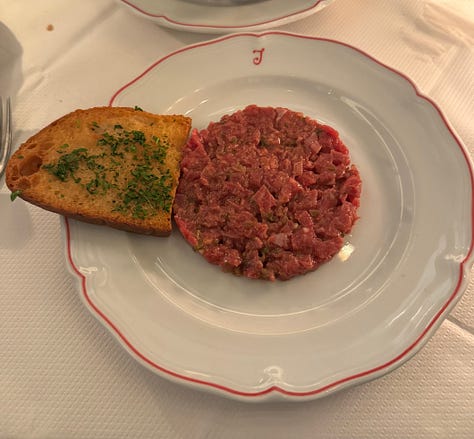
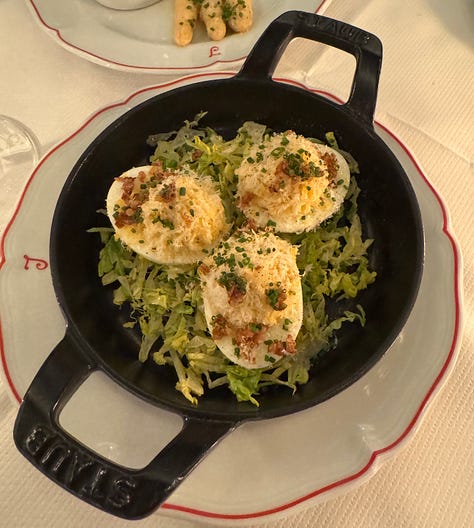
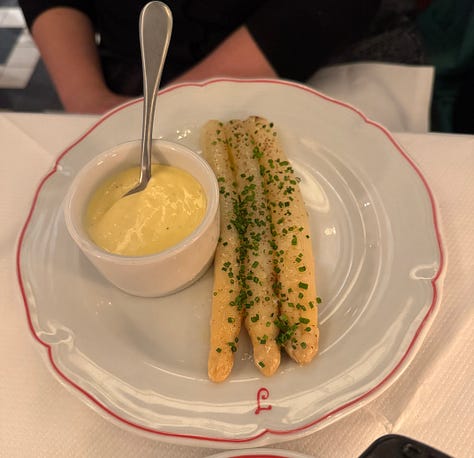
My main was “Caillettes de porc aux Epinards, Sauce Marengo.” For Brits, that’s pork & spinach faggot with marengo sauce. For Americans, it’s the world’s best and most succulent meatloaf. I want the recipe. Seriously.
My wife went for the mussels. They were big and juicy, with a flavourful white wine sauce. The only challenge was the portion size. It was gigantic. Too many to get through. But the starter portion was too small for a main. I suspect this will resolve itself in time.
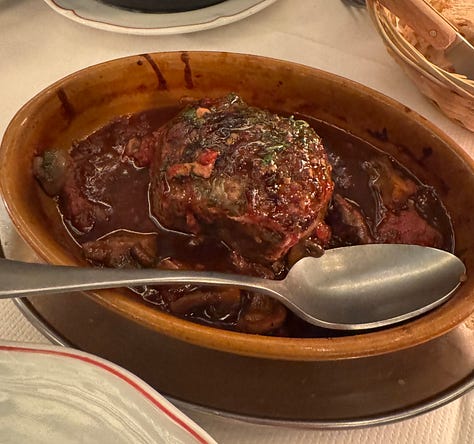
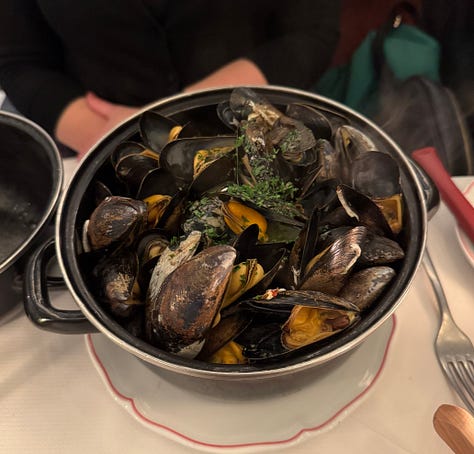
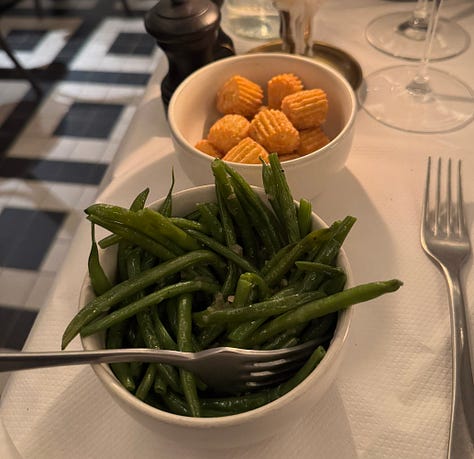
Sides included green beans and pommes Duchesse — light pillows of potato heavenliness.
For dessert, there was Grand Marnier iced soufflé, a new concept for me. I’ve now eaten it, and judged it outstanding. But I’ve got no idea how it was made. I don’t think it was baked. It’s possible that it’s ice cream in a clever mold. I don’t mind, and I don’t want to spoil the magic by looking it up. I’d happily eat it every day. We also had strawberry sponge, aka strawberry shortcake. Another winner.
So, the food and service were fabulous. But what about the space? And this where we run into trouble.
The Josephine Bouchon concept in Chelsea was laser-focused on Lyon. And it delivered with perfect authenticity. But the Lyonaisse bouchon is largely unfamiliar to most in Britain, so the intimate closeness of the seating and casual nature of the service felt properly French, somehow. (Some of the dumber takes on TripAdvisor are rooted in a misunderstanding of the concept.)
On the other hand, everyone knows what a Paris bistro feels like. Or they think they do. And there are hundreds of takes on the concept here in London and across the UK. Coren’s contextual meander is rooted in that insight. He judges that Josephine is the best yet.
I’m not so sure. Even in Paris, it’s harder than ever to define an authentic bistro. Let alone what one should feel like when exported. So it’s impossible for an exported the Paris bistro concept to feel authentic.
My wife and I were favoured with what I judged to be the best table in the restaurant. We could see everything. We considered the vibe carefully, and I walked around to the other rooms to get a sense of the whole place.
On this point, Ellis is right. It feels fake. But that’s because the whole genre now feels fake. It feels Disneyland and Café Rouge because our whole experience of the Paris bistro is dominated by the corporate interpretation. That includes actual places in Paris, redesigned to fit into a Ratatouille-inspired portrait.
There’s another problem. In The Theory and Practice Lunch, acclaimed writer Keith Waterhouse says that a place like Josephine Marylebone should have “a raffishly foreign feeling…which gives it just that required air of mild sin.” The original Josephine Bouchon in Chelsea delivers on this requirement perfectly. The Marylebone branch simply does not.
Both Ellis and Coren detect that founder Claude Bosi wants to expand the Josephine concept more broadly. His team’s confusion about the naming tends to confirm that suspicion.
When we visited Josephine Bouchon, the new place was to be called Josephine Bistro. Now the Bouchon suffix is gone from the original, and the two places are simply Josephine Chelsea and Josephine Marylebone.
All of this seems like a big mistake.
If Bosi wants to expand the concept, it’s the Lyonaisse bouchon concept that offers the greatest promise. The bistro concept is done and done. Even if Coren is right, and Josephine Marylebone is one of the best takes ever, it still won’t work as a wider concept. The Bouchon concept might.
And I preferred the more adventurous Bouchon menu to the predictable Bistro concept.
There is also a practical problem. Bosi has opened Brooklands and Josephine twice in the last 12 months. There is still two-starred Bibendum to look after. At some point, he is going to run out of capable disciples to protect his vision and his food.
The Josephine concept might have enough strength for one more outlet. Perhaps in the City or near London Bridge. I’d eagerly support it. But only in the Bouchon form. Beyond that, I think Bossi ought to stop.
Let Josephine revel in its excellence. This far, and no farther.
Quick hit: Wonderful French food and wine with a parisien accent.
Details: Booking essential. Marylebone. ££££.
Restaurant website. More on Instagram.
Find it on Google Maps. 6-8 Blandford St, W1U 4AU.
Thanks for reading this week’s review. I’m curious what you think on my point about bistros. Let me know in the Comments.






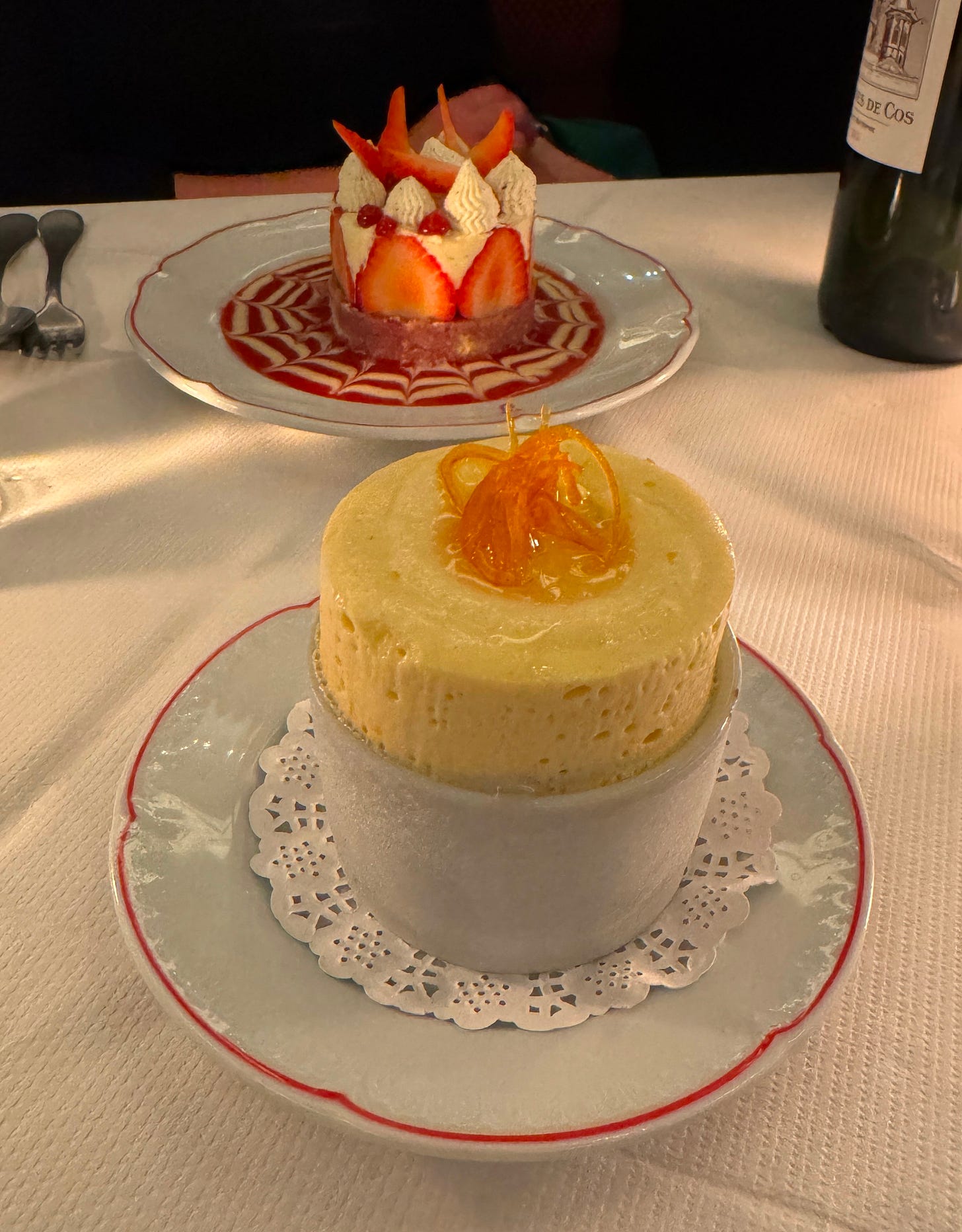

Just checked out the menu and yes please, I’m going. One complaint. On the menu under sharing - can we please stop the increasing use of ‘pax’, borrowed from the travel industry and an abbreviation of passengers, to indicate numbers? It’s a very lazy use of language and only 3 letters shorter than ‘people’.
I tried the bouchon in Chelsea for the first time last weekend and found it darn near perfect.